84 Solve Systems of Nonlinear Equations
Learning Objectives
By the end of this section, you will be able to:
- Solve a system of nonlinear equations using graphing
- Solve a system of nonlinear equations using substitution
- Solve a system of nonlinear equations using elimination
- Use a system of nonlinear equations to solve applications
Solve a System of Nonlinear Equations Using Graphing
We learned how to solve systems of linear equations with two variables by graphing, substitution and elimination. We will be using these same methods as we look at nonlinear systems of equations with two equations and two variables. A system of nonlinear equations is a system where at least one of the equations is not linear.
For example each of the following systems is a system of nonlinear equations.
A system of nonlinear equations is a system where at least one of the equations is not linear.
Just as with systems of linear equations, a solution of a nonlinear system is an ordered pair that makes both equations true. In a nonlinear system, there may be more than one solution. We will see this as we solve a system of nonlinear equations by graphing.
When we solved systems of linear equations, the solution of the system was the point of intersection of the two lines. With systems of nonlinear equations, the graphs may be circles, parabolas or hyperbolas and there may be several points of intersection, and so several solutions. Once you identify the graphs, visualize the different ways the graphs could intersect and so how many solutions there might be.
To solve systems of nonlinear equations by graphing, we use basically the same steps as with systems of linear equations modified slightly for nonlinear equations. The steps are listed below for reference.
- Identify the graph of each equation. Sketch the possible options for intersection.
- Graph the first equation.
- Graph the second equation on the same rectangular coordinate system.
- Determine whether the graphs intersect.
- Identify the points of intersection.
- Check that each ordered pair is a solution to both original equations.
Solve the system by graphing: ![]()
| Identify each graph. | |
| Sketch the possible options for intersection of a parabola and a line. |
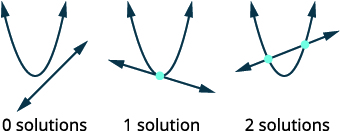 |
| Graph the line, Slope-intercept form Graph the parabola, |
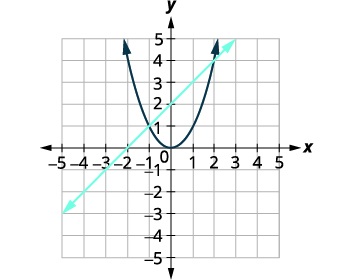 |
| Identify the points of intersection. | The points of intersection appear to be |
| Check to make sure each solution makes both equations true.   |
|
| The solutions are |
Solve the system by graphing: ![]()
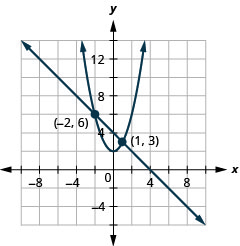
Solve the system by graphing: ![]()
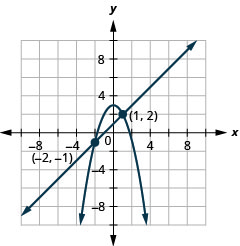
To identify the graph of each equation, keep in mind the characteristics of the ![]() and
and ![]() terms of each conic.
terms of each conic.
Solve the system by graphing: ![]()
| Identify each graph. | |
| Sketch the possible options for the intersection of a circle and a line. |
 |
| Graph the circle, Center: Graph the line, It is a horizontal line. |
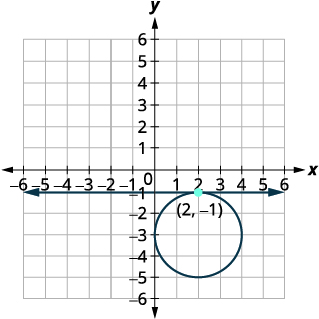 |
| Identify the points of intersection. | The point of intersection appears to be |
| Check to make sure the solution makes both equations true.  |
|
| The solution is |
Solve the system by graphing: ![]()
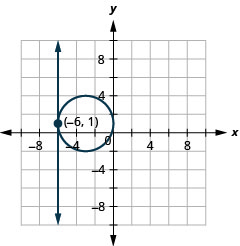
Solve the system by graphing: ![]()
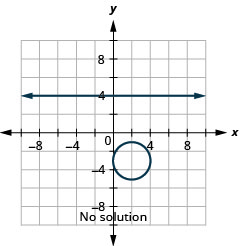
Solve a System of Nonlinear Equations Using Substitution
The graphing method works well when the points of intersection are integers and so easy to read off the graph. But more often it is difficult to read the coordinates of the points of intersection. The substitution method is an algebraic method that will work well in many situations. It works especially well when it is easy to solve one of the equations for one of the variables.
The substitution method is very similar to the substitution method that we used for systems of linear equations. The steps are listed below for reference.
- Identify the graph of each equation. Sketch the possible options for intersection.
- Solve one of the equations for either variable.
- Substitute the expression from Step 2 into the other equation.
- Solve the resulting equation.
- Substitute each solution in Step 4 into one of the original equations to find the other variable.
- Write each solution as an ordered pair.
- Check that each ordered pair is a solution to both original equations.
Solve the system by using substitution: ![]()
| Identify each graph. | |
| Sketch the possible options for intersection of an ellipse and a line. |
 |
| The equation |
 |
 |
|
| Substitute |
 |
| Solve the equation for x. |  |
 |
|
| Substitute |
 |
 |
|
| The ordered pairs are |
|
Check both ordered pairs in both equations.  |
|
| The solutions are |
Solve the system by using substitution: ![]()
No solution
Solve the system by using substitution: ![]()
![]()
So far, each system of nonlinear equations has had at least one solution. The next example will show another option.
Solve the system by using substitution: ![]()
| Identify each graph. | |
| Sketch the possible options for intersection of a parabola and a line |
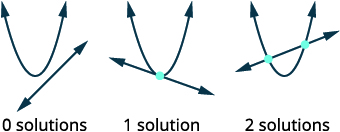 |
| The equation |
 |
 |
|
| Substitute |
 |
| Solve the equation for x. |  |
| This doesn’t factor easily, so we can check the discriminant. |
|
 |
The discriminant is negative, so there is no real solution. The system has no solution. |
Solve the system by using substitution: ![]()
No solution
Solve the system by using substitution: ![]()
![]()
Solve a System of Nonlinear Equations Using Elimination
When we studied systems of linear equations, we used the method of elimination to solve the system. We can also use elimination to solve systems of nonlinear equations. It works well when the equations have both variables squared. When using elimination, we try to make the coefficients of one variable to be opposites, so when we add the equations together, that variable is eliminated.
The elimination method is very similar to the elimination method that we used for systems of linear equations. The steps are listed for reference.
- Identify the graph of each equation. Sketch the possible options for intersection.
- Write both equations in standard form.
- Make the coefficients of one variable opposites.
Decide which variable you will eliminate.
Multiply one or both equations so that the coefficients of that variable are opposites. - Add the equations resulting from Step 3 to eliminate one variable.
- Solve for the remaining variable.
- Substitute each solution from Step 5 into one of the original equations. Then solve for the other variable.
- Write each solution as an ordered pair.
- Check that each ordered pair is a solution to both original equations.
Solve the system by elimination: ![]()
| Identify each graph. |  |
| Sketch the possible options for intersection of a circle and a parabola. |
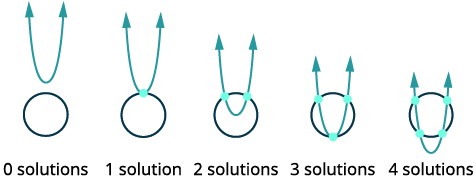 |
| Both equations are in standard form. |  |
| To get opposite coefficients of we will multiply the second equation by |
 |
| Simplify. |  |
| Add the two equations to eliminate |
 |
| Solve for y. |  |
 |
|
| Substitute the original equations. Then solve for x. |
 |
 |
|
| Write each solution as an ordered pair. | The ordered pairs are |
| Check that each ordered pair is a solution to both original equations. |
|
| We will leave the checks for each of the four solutions to you. |
The solutions are |
Solve the system by elimination: ![]()
![]()
Solve the system by elimination: ![]()
![]()
There are also four options when we consider a circle and a hyperbola.
Solve the system by elimination: ![]()
| Identify each graph. | |
| Sketch the possible options for intersection of a circle and hyperbola. |
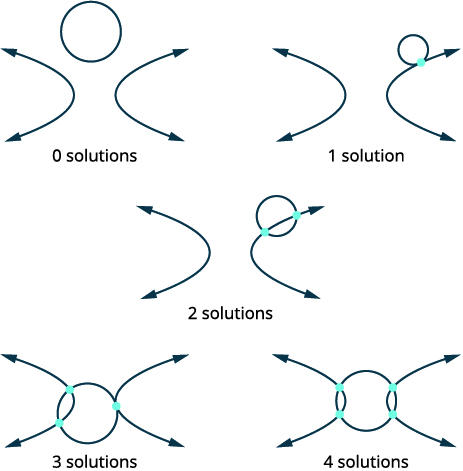 |
| Both equations are in standard form. | |
| The coefficients of will add the equations. |
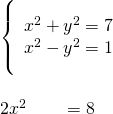 |
| Simplify. | |
| Substitute original equations. Then solve for y. |
 |
| Write each solution as an ordered pair. | The ordered pairs are |
| Check that the ordered pair is a solution to both original equations. |
|
| We will leave the checks for each of the four solutions to you. |
The solutions are and |
Solve the system by elimination: ![]()
![]()
Solve the system by elimination: ![]()
![]()
Use a System of Nonlinear Equations to Solve Applications
Systems of nonlinear equations can be used to model and solve many applications. We will look at an everyday geometric situation as our example.
The difference of the squares of two numbers is 15. The sum of the numbers is 5. Find the numbers.
| Identify what we are looking for. | Two different numbers. |
| Define the variables. | |
| Translate the information into a system of equations. |
|
| First sentence. | The difference of the squares of two numbers is 15. |
 |
|
| Second sentence. | The sum of the numbers is 5. |
 |
|
| Solve the system by substitution |  |
| Solve the second equation for x. |  |
| Substitute x into the first equation. |  |
 |
|
| Expand and simplify. |  |
 |
|
| Solve for y. |  |
 |
|
| Substitute back into the second equation. |  |
 |
|
| The numbers are 1 and 4. |
The difference of the squares of two numbers is ![]() The sum of the numbers is 10. Find the numbers.
The sum of the numbers is 10. Find the numbers.
4 and 6
The difference of the squares of two numbers is 35. The sum of the numbers is ![]() Find the numbers.
Find the numbers.
![]() and 17
and 17
Myra purchased a small 25” TV for her kitchen. The size of a TV is measured on the diagonal of the screen. The screen also has an area of 300 square inches. What are the length and width of the TV screen?
| Identify what we are looking for. | The length and width of the rectangle |
| Define the variables. | Let |
| Draw a diagram to help visualize the situation. |  |
| Area is 300 square inches. | |
| Translate the information into a system of equations. |
The diagonal of the right triangle is 25 inches. |
 |
|
| The area of the rectangle is 300 square inches. | |
 |
|
| Solve the system using substitution. |  |
| Solve the second equation for x. |  |
| Substitute x into the first equation. |  |
 |
|
| Simplify. |  |
| Multiply by |
 |
| Put in standard form. |  |
| Solve by factoring. |  |
 |
|
 |
|
| Since y is a side of the rectangle, we discard the negative values. |
 |
| Substitute back into the second equation. |  |
 |
|
| If the length is 15 inches, the width is 20 inches. | |
| If the length is 20 inches, the width is 15 inches. |
Edgar purchased a small 20” TV for his garage. The size of a TV is measured on the diagonal of the screen. The screen also has an area of 192 square inches. What are the length and width of the TV screen?
If the length is 12 inches, the width is 16 inches. If the length is 16 inches, the width is 12 inches.
The Harper family purchased a small microwave for their family room. The diagonal of the door measures 15 inches. The door also has an area of 108 square inches. What are the length and width of the microwave door?
If the length is 12 inches, the width is 9 inches. If the length is 9 inches, the width is 12 inches.
Access these online resources for additional instructions and practice with solving nonlinear equations.
Key Concepts
- How to solve a system of nonlinear equations by graphing.
- Identify the graph of each equation. Sketch the possible options for intersection.
- Graph the first equation.
- Graph the second equation on the same rectangular coordinate system.
- Determine whether the graphs intersect.
- Identify the points of intersection.
- Check that each ordered pair is a solution to both original equations.
- How to solve a system of nonlinear equations by substitution.
- Identify the graph of each equation. Sketch the possible options for intersection.
- Solve one of the equations for either variable.
- Substitute the expression from Step 2 into the other equation.
- Solve the resulting equation.
- Substitute each solution in Step 4 into one of the original equations to find the other variable.
- Write each solution as an ordered pair.
- Check that each ordered pair is a solution to both original equations.
- Identify the graph of each equation. Sketch the possible options for intersection.
- How to solve a system of equations by elimination.
- Identify the graph of each equation. Sketch the possible options for intersection.
- Write both equations in standard form.
- Make the coefficients of one variable opposites.
Decide which variable you will eliminate.
Multiply one or both equations so that the coefficients of that variable are opposites. - Add the equations resulting from Step 3 to eliminate one variable.
- Solve for the remaining variable.
- Substitute each solution from Step 5 into one of the original equations. Then solve for the other variable.
- Write each solution as an ordered pair.
- Check that each ordered pair is a solution to both original equations.
Section Exercises
Practice Makes Perfect
Solve a System of Nonlinear Equations Using Graphing
In the following exercises, solve the system of equations by using graphing.
![]()
![]()
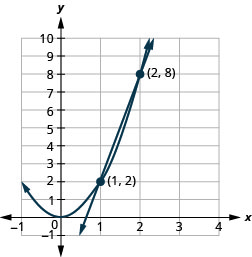
![]()
![]()
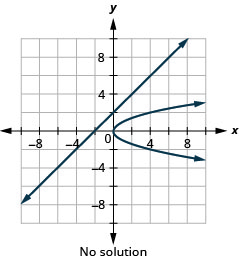
![]()
![]()
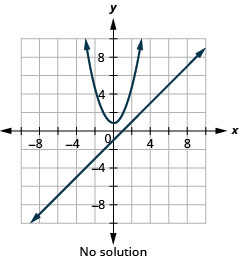
![]()
![]()
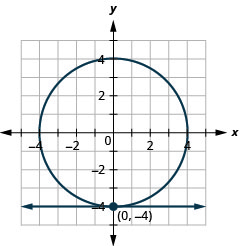
![]()
![]()
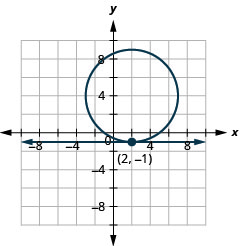
![]()
![]()
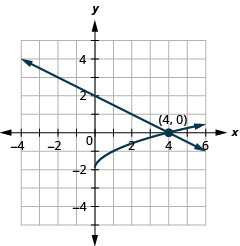
Solve a System of Nonlinear Equations Using Substitution
In the following exercises, solve the system of equations by using substitution.
![]()
![]()
![]()
![]()
![]()
![]()
![]()
![]()
![]()
![]()
![]()
No solution
![]()
![]()
![]()
![]()
![]()
![]()
Solve a System of Nonlinear Equations Using Elimination
In the following exercises, solve the system of equations by using elimination.
![]()
![]()
![]()
![]()
![]()
![]()
![]()
![]()
![]()
![]()
![]()
![]()
![]()
![]()
![]()
![]()
![]()
![]()
![]()
![]()
![]()
![]()
![]()
![]()
Use a System of Nonlinear Equations to Solve Applications
In the following exercises, solve the problem using a system of equations.
The sum of two numbers is ![]() and the product is 8. Find the numbers.
and the product is 8. Find the numbers.
The sum of two numbers is 11 and the product is ![]() Find the numbers.
Find the numbers.
![]() and 14
and 14
The sum of the squares of two numbers is 65. The difference of the number is 3. Find the numbers.
The sum of the squares of two numbers is 113. The difference of the number is 1. Find the numbers.
![]() and
and ![]() or 8 and 7
or 8 and 7
The difference of the squares of two numbers is 15. The difference of twice the square of the first number and the square of the second number is 30. Find the numbers.
The difference of the squares of two numbers is 20. The difference of the square of the first number and twice the square of the second number is 4. Find the numbers.
![]() and
and ![]() or
or ![]() and 4 or 6 and
and 4 or 6 and ![]() or 6 and 4
or 6 and 4
The perimeter of a rectangle is 32 inches and its area is 63 square inches. Find the length and width of the rectangle.
The perimeter of a rectangle is 52 cm and its area is 165 ![]() Find the length and width of the rectangle.
Find the length and width of the rectangle.
If the length is 11 cm, the width is 15 cm. If the length is 15 cm, the width is 11 cm.
Dion purchased a new microwave. The diagonal of the door measures 17 inches. The door also has an area of 120 square inches. What are the length and width of the microwave door?
Jules purchased a microwave for his kitchen. The diagonal of the front of the microwave measures 26 inches. The front also has an area of 240 square inches. What are the length and width of the microwave?
If the length is 10 inches, the width is 24 inches. If the length is 24 inches, the width is 10 inches.
Roman found a widescreen TV on sale, but isn’t sure if it will fit his entertainment center. The TV is 60”. The size of a TV is measured on the diagonal of the screen and a widescreen has a length that is larger than the width. The screen also has an area of 1728 square inches. His entertainment center has an insert for the TV with a length of 50 inches and width of 40 inches. What are the length and width of the TV screen and will it fit Roman’s entertainment center?
Donnette found a widescreen TV at a garage sale, but isn’t sure if it will fit her entertainment center. The TV is 50”. The size of a TV is measured on the diagonal of the screen and a widescreen has a length that is larger than the width. The screen also has an area of 1200 square inches. Her entertainment center has an insert for the TV with a length of 38 inches and width of 27 inches. What are the length and width of the TV screen and will it fit Donnette’s entertainment center?
The length is 40 inches and the width is 30 inches. The TV will not fit Donnette’s entertainment center.
Writing Exercises
In your own words, explain the advantages and disadvantages of solving a system of equations by graphing.
Explain in your own words how to solve a system of equations using substitution.
Answers will vary.
Explain in your own words how to solve a system of equations using elimination.
A circle and a parabola can intersect in ways that would result in 0, 1, 2, 3, or 4 solutions. Draw a sketch of each of the possibilities.
Answers will vary.
Self Check
ⓐ After completing the exercises, use this checklist to evaluate your mastery of the objectives of this section.
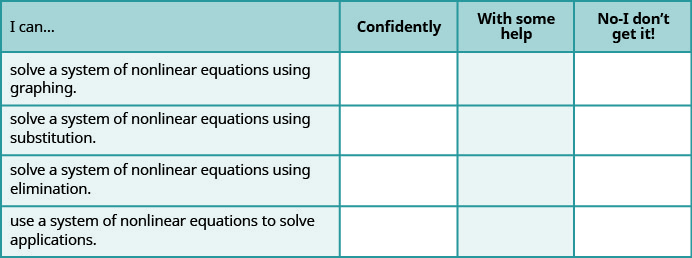
ⓑ After looking at the checklist, do you think you are well-prepared for the next section? Why or why not?
Chapter Review Exercises
Distance and Midpoint Formulas; Circles
Use the Distance Formula
In the following exercises, find the distance between the points. Round to the nearest tenth if needed.
![]() and
and ![]()
![]() and
and ![]()
![]()
![]() and
and ![]()
![]() and
and ![]()
![]()
Use the Midpoint Formula
In the following exercises, find the midpoint of the line segments whose endpoints are given.
![]() and
and ![]()
![]() and
and ![]()
![]()
![]() and
and ![]()
![]() and
and ![]()
![]()
Write the Equation of a Circle in Standard Form
In the following exercises, write the standard form of the equation of the circle with the given information.
radius is 15 and center is ![]()
radius is ![]() and center is
and center is ![]()
![]()
radius is 9 and center is ![]()
radius is 7 and center is ![]()
![]()
center is ![]() and a point on the circle is
and a point on the circle is ![]()
center is ![]() and a point on the circle is
and a point on the circle is ![]()
![]()
Graph a Circle
In the following exercises, ⓐ find the center and radius, then ⓑ graph each circle.
![]()
![]()
ⓐ radius: 12, center: ![]()
ⓑ
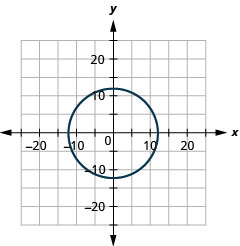
![]()
![]()
ⓐ radius: 7, center: ![]()
ⓑ
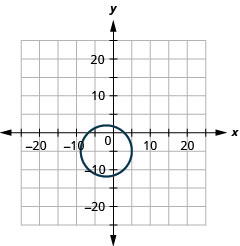
![]()
![]()
ⓐ radius: 8, center: ![]()
ⓑ
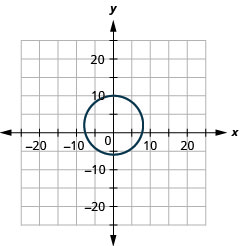
Parabolas
Graph Vertical Parabolas
In the following exercises, graph each equation by using its properties.
![]()
![]()
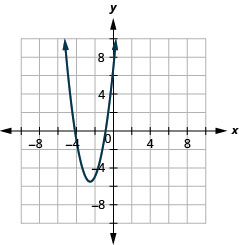
![]()
![]()
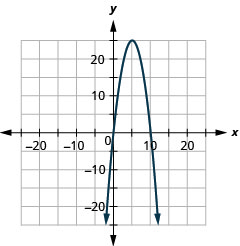
In the following exercises, ⓐ write the equation in standard form, then ⓑ use properties of the standard form to graph the equation.
![]()
![]()
ⓐ![]()
ⓑ
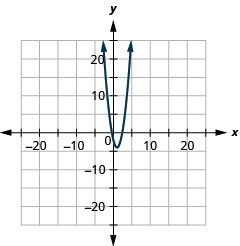
![]()
![]()
ⓐ![]()
ⓑ
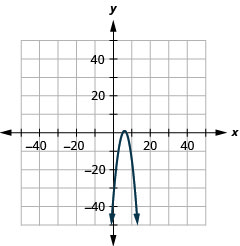
Graph Horizontal Parabolas
In the following exercises, graph each equation by using its properties.
![]()
![]()
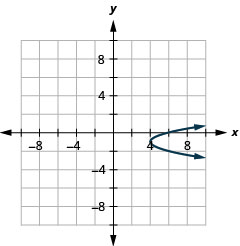
![]()
![]()
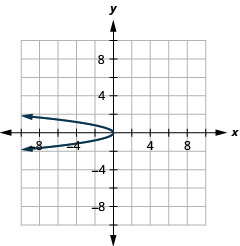
In the following exercises, ⓐ write the equation in standard form, then ⓑ use properties of the standard form to graph the equation.
![]()
![]()
ⓐ![]()
ⓑ
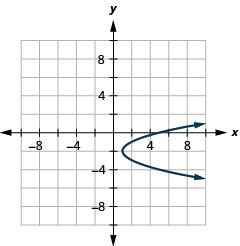
![]()
![]()
ⓐ![]()
ⓑ
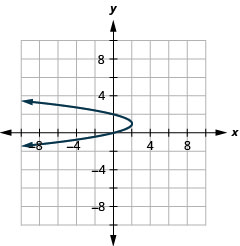
Solve Applications with Parabolas
In the following exercises, create the equation of the parabolic arch formed in the foundation of the bridge shown. Give the answer in standard form.


![]()
Ellipses
Graph an Ellipse with Center at the Origin
In the following exercises, graph each ellipse.
![]()
![]()
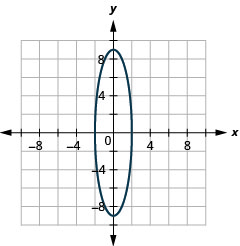
![]()
![]()
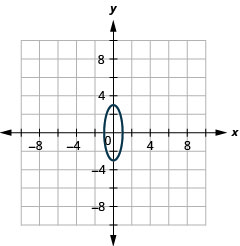
Find the Equation of an Ellipse with Center at the Origin
In the following exercises, find the equation of the ellipse shown in the graph.
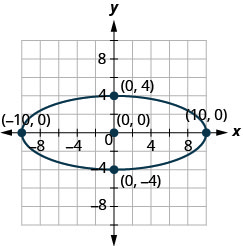
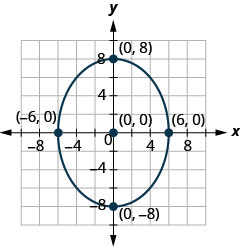
![]()
Graph an Ellipse with Center Not at the Origin
In the following exercises, graph each ellipse.
![]()
![]()
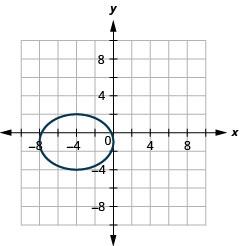
![]()
![]()
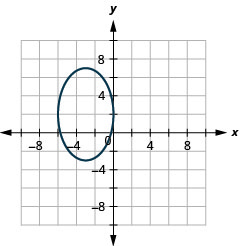
In the following exercises, ⓐ write the equation in standard form and ⓑ graph.
![]()
![]()
ⓐ![]()
ⓑ
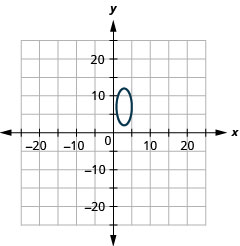
![]()
![]()
ⓐ![]()
ⓑ
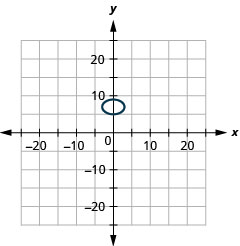
Solve Applications with Ellipses
In the following exercises, write the equation of the ellipse described.
A comet moves in an elliptical orbit around a sun. The closest the comet gets to the sun is approximately 10 AU and the furthest is approximately 90 AU. The sun is one of the foci of the elliptical orbit. Letting the ellipse center at the origin and labeling the axes in AU, the orbit will look like the figure below. Use the graph to write an equation for the elliptical orbit of the comet.
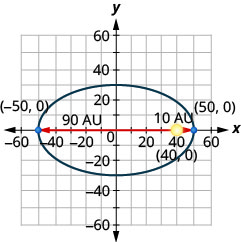
Hyperbolas
Graph a Hyperbola with Center at ![]()
In the following exercises, graph.
![]()
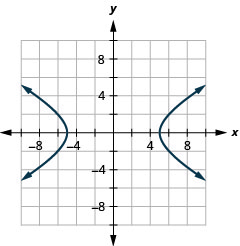
![]()
![]()
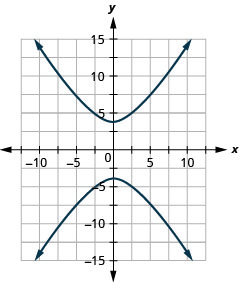
![]()
Graph a Hyperbola with Center at ![]()
In the following exercises, graph.
![]()
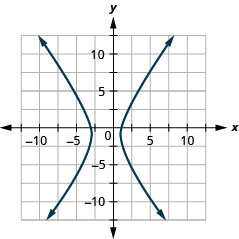
![]()
![]()
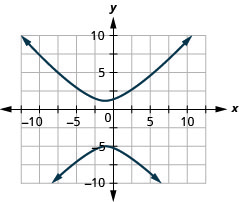
![]()
In the following exercises, ⓐ write the equation in standard form and ⓑ graph.
![]()
ⓐ![]()
ⓑ
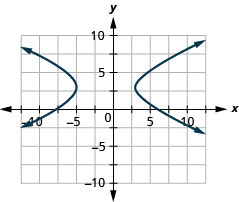
![]()
![]()
ⓐ![]()
ⓑ
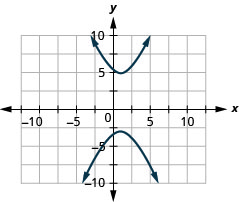
![]()
Identify the Graph of each Equation as a Circle, Parabola, Ellipse, or Hyperbola
In the following exercises, identify the type of graph.
ⓐ![]()
ⓑ![]()
ⓒ![]()
ⓓ![]()
ⓐ hyperbola ⓑ circle ⓒ parabola ⓓ ellipse
ⓐ![]()
ⓑ![]()
ⓒ![]()
ⓓ![]()
Solve Systems of Nonlinear Equations
Solve a System of Nonlinear Equations Using Graphing
In the following exercises, solve the system of equations by using graphing.
![]()
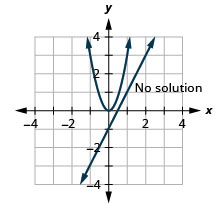
![]()
![]()
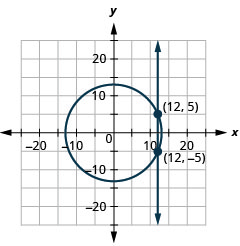
![]()
Solve a System of Nonlinear Equations Using Substitution
In the following exercises, solve the system of equations by using substitution.
![]()
![]()
![]()
![]()
No solution
![]()
Solve a System of Nonlinear Equations Using Elimination
In the following exercises, solve the system of equations by using elimination.
![]()
![]()
![]()
![]()
![]()
![]()
Use a System of Nonlinear Equations to Solve Applications
In the following exercises, solve the problem using a system of equations.
The sum of the squares of two numbers is 25. The difference of the numbers is 1. Find the numbers.
![]() and
and ![]() or 4 and 3
or 4 and 3
The difference of the squares of two numbers is 45. The difference of the square of the first number and twice the square of the second number is 9. Find the numbers.
The perimeter of a rectangle is 58 meters and its area is 210 square meters. Find the length and width of the rectangle.
If the length is 14 inches, the width is 15 inches. If the length is 15 inches, the width is 14 inches.
Colton purchased a larger microwave for his kitchen. The diagonal of the front of the microwave measures 34 inches. The front also has an area of 480 square inches. What are the length and width of the microwave?
Practice Test
In the following exercises, find the distance between the points and the midpoint of the line segment with the given endpoints. Round to the nearest tenth as needed.
![]() and
and ![]()
distance: 10, midpoint: ![]()
![]() and
and ![]()
In the following exercises, write the standard form of the equation of the circle with the given information.
radius is 11 and center is ![]()
![]()
radius is 12 and center is ![]()
center is ![]() and a point on the circle is
and a point on the circle is ![]()
![]()
Find the equation of the ellipse shown in the graph.
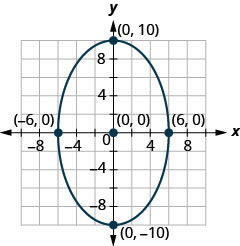
In the following exercises, ⓐ identify the type of graph of each equation as a circle, parabola, ellipse, or hyperbola, and ⓑ graph the equation.
![]()
ⓐ ellipse
ⓑ
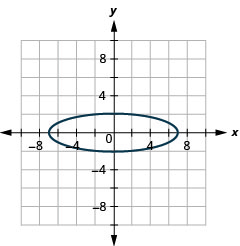
![]()
![]()
ⓐ circle
ⓑ
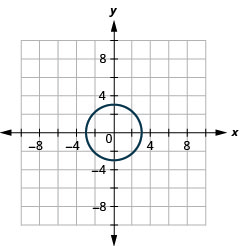
![]()
![]()
ⓐ ellipse
ⓑ
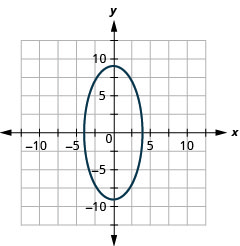
![]()
![]()
ⓐ hyperbola
ⓑ
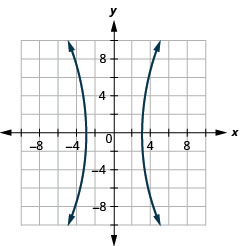
In the following exercises, ⓐ identify the type of graph of each equation as a circle, parabola, ellipse, or hyperbola, ⓑ write the equation in standard form, and ⓒ graph the equation.
![]()
![]()
ⓐ circle
ⓑ ![]()
ⓒ
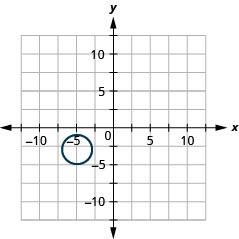
![]()
![]()
ⓐ hyperbola
ⓑ ![]()
ⓒ
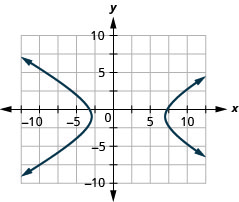
![]()
Solve the nonlinear system of equations by graphing:![]()
No solution
Solve the nonlinear system of equations using substitution:![]()
Solve the nonlinear system of equations using elimination:![]()
![]()
Create the equation of the parabolic arch formed in the foundation of the bridge shown. Give the answer in ![]() form.
form.

A comet moves in an elliptical orbit around a sun. The closest the comet gets to the sun is approximately 20 AU and the furthest is approximately 70 AU. The sun is one of the foci of the elliptical orbit. Letting the ellipse center at the origin and labeling the axes in AU, the orbit will look like the figure below. Use the graph to write an equation for the elliptical orbit of the comet.
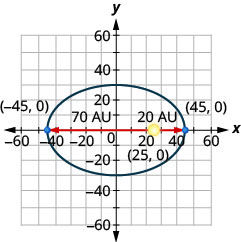
![]()
The sum of two numbers is 22 and the product is ![]() Find the numbers.
Find the numbers.
For her birthday, Olive’s grandparents bought her a new widescreen TV. Before opening it she wants to make sure it will fit her entertainment center. The TV is 55”. The size of a TV is measured on the diagonal of the screen and a widescreen has a length that is larger than the width. The screen also has an area of 1452 square inches. Her entertainment center has an insert for the TV with a length of 50 inches and width of 40 inches. What are the length and width of the TV screen and will it fit Olive’s entertainment center?
The length is 44 inches and the width is 33 inches. The TV will fit Olive’s entertainment center.
Glossary
- system of nonlinear equations
- A system of nonlinear equations is a system where at least one of the equations is not linear.

